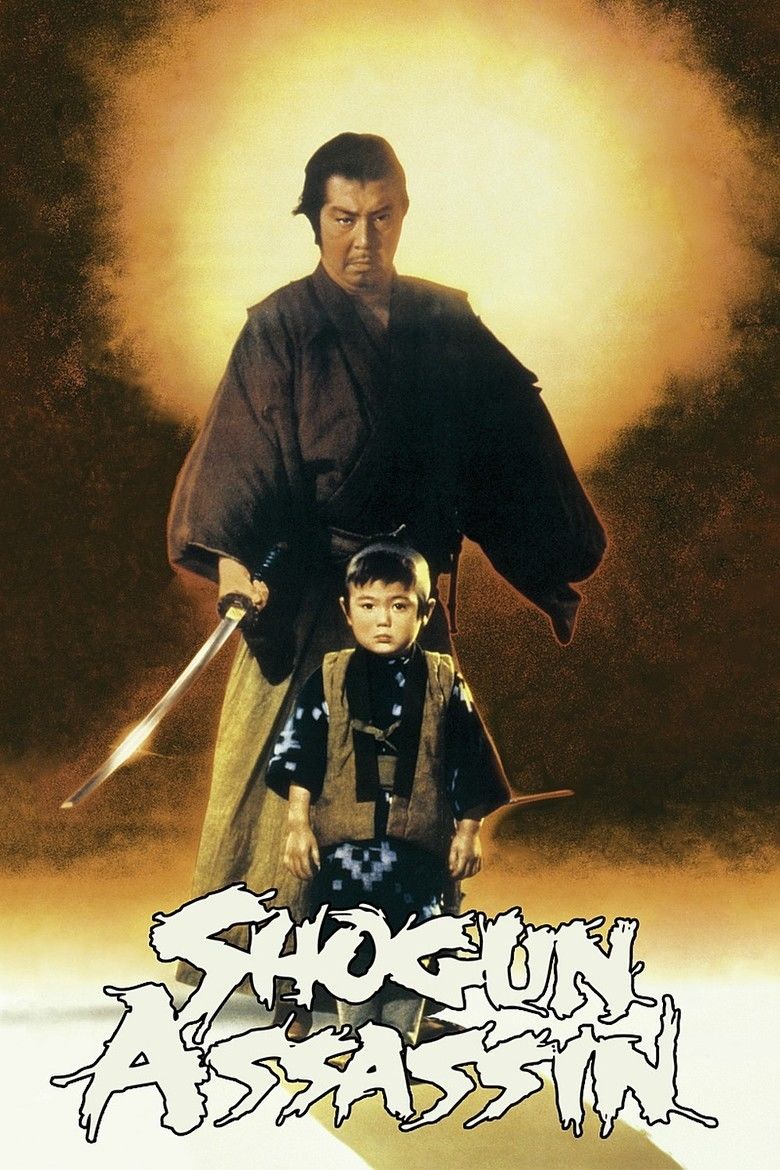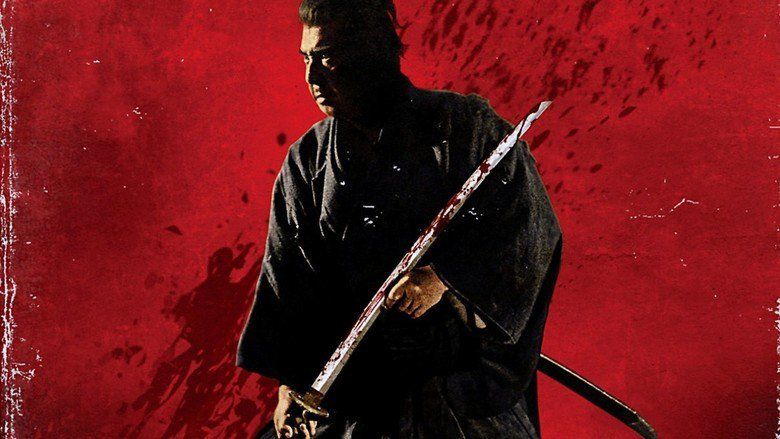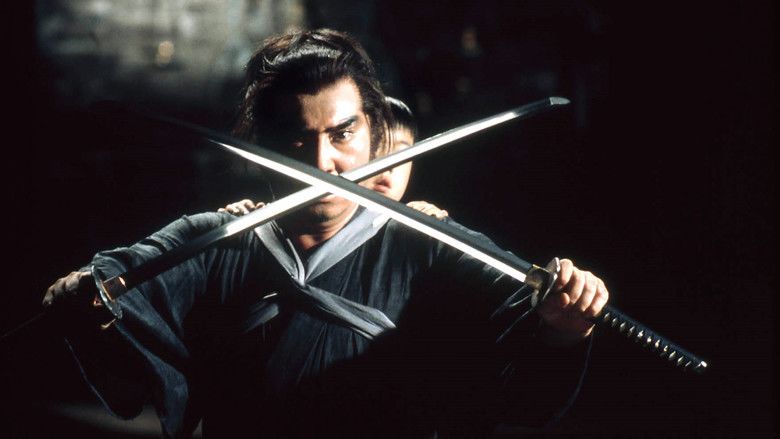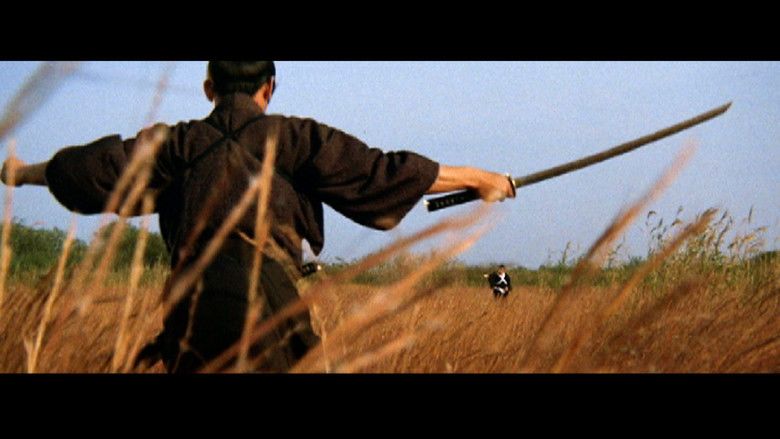Shogun Assassin
7.4 /10 1 Votes
Film series Lone Wolf and Cub Country Japan | 7.4/10 IMDb Genre Action, Adventure Duration | |||||||||||||||||||||||||||||||||
 | ||||||||||||||||||||||||||||||||||
Release date November 11, 1980 Writer Robert Houston, Kazuo Koike (screenplay), Kazuo Koike (story), Goseki Kojima, David Weisman, Bobby White (subtitles) Initial DVD release November 14, 2006 (Hungary) Cast (Ogami Itto), Akihiro Tomikawa (Daigoro), (Supreme Ninja), Minoru Oki (Master of Death (as Minoru Ohki)), (Master of Death (as Shoji Kobayashi)), Shin Kishida (Master of Death)Similar movies Mad Max: Fury Road , John Wick , Furious 7 , Taken 3 , Teenage Mutant Ninja Turtles , The Equalizer Tagline The legend of lone wolf and cub continues! | ||||||||||||||||||||||||||||||||||
Shogun assassin 1980 trailer
Shogun Assassin, known in Japan as Kozure Ōkami (子連れ狼), is a jidaigeki film made for the British and American markets and released in 1980. In 2006 it was restored and re-released on DVD in the United States by AnimEigo.
Contents
- Shogun assassin 1980 trailer
- Shogun assassin hd trailer
- Plot
- Cast
- Production
- Release
- Reception
- Sequels
- In popular culture
- References

Shogun Assassin was edited and compiled from the first two films in the Lone Wolf and Cub series, using 12 minutes of the first film, Lone Wolf and Cub: Sword of Vengeance (Kozure Ōkami: Kowokashi udekashi tsukamatsuru or Wolf with Child in Tow: Child and Expertise for Rent), and most of Lone Wolf and Cub: Baby Cart at the River Styx (Kozure Ōkami: Sanzu no kawa no ubaguruma or Wolf with Child in Tow: Perambulator of the River of Sanzu). Both were originally released in 1972. There were six films in all in the series. These in turn were based on the long-running 1970s manga series, Lone Wolf and Cub, created by the writer Kazuo Koike and the artist Goseki Kojima.

The project was directed by Robert Houston and his partner David Weisman, a protégé of Andy Warhol and director of Ciao! Manhattan (1972). A fan of the original Kozure Ōkami films, Weisman had obtained the rights for $50,000 from the American office of Toho Studios. The film was distributed by Roger Corman's New World Pictures to the grindhouse movie circuit in the United States, and then later as a video cassette from MCA/Universal Home Video. When released in the United Kingdom by the Vipco video tape label in 1983, Shogun Assassin's extreme violence almost caused it to be banned by the Home Office. Vipco played this for publicity in the cover art of their 2000 release on DVD, which was stamped "Banned since 1983!” The poster and title treatment was created by artist Jim Evans, Jim’s son Gibran Evans voiced the narrative as Daigorō.

The title character, Ogami Ittō, is played by Tomisaburo Wakayama, brother of the producer, Shintaro Katsu, who is known for playing Zatoichi in a series of 26 films starting in the 1960s. As a result, it has garnered a cult following.

Shogun assassin hd trailer
Plot
As the opening credits roll, an abbreviated version of Ogami Ittō's (Tomisaburô Wakayama) past as Shogunate Decapitator and his wife's murder by ninja are seen, with Daigorō (Akihiro Tomikawa) providing the narration.
Two hooded samurai attack Ogami while he is pushing a cart with Daigorō inside. Ogami fends off the attack of the first, breaking the samurai's sword and splitting his head. The second attacker jumps over the first, with the first still clasping Ogami's blade. Ogami pulls off a handrail from the cart and a blade comes out, transforming it into a spear. Ogami then uses the spear to impale the second attacker. As the first is dying, he reminds Ogami that he is marked for death.
As Ogami and Daigorō sit by a roadside fire and eat their evening meal, Ogami remembers how he offered the infant Daigorō the life-death choice: either Ogami's sword (which would mean that Daigorō would join him on his mission of vengeance against the Shogun) or Daigorō's ball (which would mean that Daigorō would be killed, so that he could be with his mother in heaven). Daigorō chooses the sword. The next day, the Shogun's officials bring Ogami the Shogun's orders: either swear eternal loyalty or commit suicide with Daigorō. Ogami decides to fight his way to freedom with Daigorō, only to have his path blocked by the Shogun and his men. The Shogun challenges Ogami to fight Kurando (the Shogun's son) in a duel; if Ogami wins, he wins his freedom. Ogami accepts, and eventually cuts off Kurando's head.
Ogami and Daigorō journey on, never stopping in one place for very long as the Shogun's ninjas are always following them. As they wander, Daigorō recalls how Lord Bizen (Taketoshi Naitô) and his men were given orders to kill him. Even though Bizen's men are wearing chain mail beneath their robes, Ogami's skill and blade are too powerful. Ogami lures Lord Bizen into the middle of a stream and uses an underwater sword-slash technique to kill him. Ogami sees the Shogun watching from a distance and he swears to the Shogun that he will destroy him and all of his ninjas.
The Supreme Ninja (Kayo Matsuo) receives orders from the Shogun to kill Ogami and Daigorō. Lord Kurogawa (Akiji Kobayashi) doesn't believe the Supreme Ninja's women are up to the task, so she proves otherwise by ordering her ninja's to kill Junai (Kurogawa's strongest ninja).
Ogami and Daigorō meet secretly with a client to discuss a business proposition. Ogami is offered the task of killing Lord Kiru (the Shogun's brother), and in return he will receive ten pieces of gold. Ogami accepts the mission and is told that Lord Kiru is being escorted by a three-brother team known as the 'Masters of Death.'
During Ogami and Daigorō's journey to find Lord Kiru, they are attacked several times by The Supreme Ninja's women. Ogami kills them each time. Ogami finally faces the Supreme Ninja herself. She attacks Ogami with a weighted net that contains fishhooks, but Ogami cuts himself free and the Supreme Ninja flees by running away backward.
Ogami and Daigorō keep on traveling, but they now come face-to-face with Lord Kurogawa's entire ninja force. Pushing Daigorō in his cart to safety, Ogami uses the spear blades in the cart's handrails to attack. All but two of the ninja are cut down, but Ogami is left wounded. He manages to push Daigorō to the safety of a deserted hut before collapsing from loss of blood. Daigorō goes in search of water for his father, finally bringing it back in his mouth, then takes some food offerings from a roadside shrine, leaving his jacket in honorable exchange.
The Supreme Ninja meets with Lord Kurogawa to report her failure but Lord Kurogawa has another plan: to strike at Ogami through Daigorō.
Later that night, Daigorō is lured outside the hut by the sound of a woman singing. Waking up to find Daigorō gone, Ogami searches for his son. He finds Daigorō is a prisoner of Lord Kurogawa and the Supreme Ninja. Daigorō is tied up and suspended over a deep well. Kuroawa demands that Ogami surrender, or he will drop Daigorō down the well. Ogami refuses, so Kurogawa and his men attack. Kurogawa lets go of the rope suspending Daigorō over the well, but Ogami manages to stamp his foot down on the rope and kill Kurogawa (and his two ninjas) at the same time. Ignoring the Supreme Ninja, who has not moved throughout the fight, Ogami carefully pulls Daigorō up to safety. Instead of killing the Supreme Ninja, Ogami walks away with Daigorō.
Ogami and Daigorō board a ship which is carrying the 'Masters of Death' to their rendezvous with Lord Kiru. Also on board is the Supreme Ninja. During the night, the remaining rebels start a fire on board the ship. In the ensuing inferno, the 'Masters of Death' tell Ogami that they recognize him, but that they will not attack him as along as he makes no move against them. Ogami agrees to their terms and they leave him. The companionway is blocked by flames, so he cuts through the deck planking. Ogami then puts Daigorō in his cart and throws them both overboard to safety. The Supreme Ninja attacks Ogami from underwater but he overpowers her. Getting Daigorō, himself and the Supreme Ninja to shore and to the shelter of a fisherman's hut, he strips all three of them naked and gathers them close together, telling the Supreme Ninja that they must share their body heat or die. The Supreme Ninja doesn't understand why he would save her and realizes she cannot kill Ogami or his son. The next day, Ogami and Daigorō leave her there, knowing that she will have to return to the Shogun, report her failure and commit suicide.
The 'Masters of Death' escort Lord Kiru and his entourage through a desert area, where they are attacked by a rebel force concealed under the sand. The 'Masters of Death' then fight off and kill all of the rebels. Lord Kiru is taken to safety. However, they haven't gone far before they see Daigorō standing in their way. He points to Ogami, who is waiting. The 'Masters of Death' finally face off against Ogami, but one by one they are cut down and killed. Ogami then chases after Lord Kiru's procession, driving off the guards. Lord Kiru protests that he is the Shogun's brother, but Ogami tells Kiru that the "Shogun means nothing" to him. Ogami then kills Lord Kiru with his sword.
As he and his father walk away from the carnage, Daigorō looks back one last time and says via voice-over, "I guess I wish it was different ... but a wish is only a wish".
Cast
Production
Shogun Assassin is a combination of two Japanese films, predominantly that of Baby-cart at the River Styx (1972) and 12 minutes of Sword of Vengeance.
Release
Shogun Assassin was released theatrically in the United States 11 November 1980 where it was distributed by New World Pictures. Shogun Assassin was released to home video by AnimEigo in 2006.
Reception
From contemporary reviews, Vincent Canby of The New York Times, wrote Shogun Assassin "is as furiuously [sic] mixed up as 'What's Up, Tiger Lily?'" and that outside "the little-boy's narration, the movie's not much fun once you've gotten the picture, which is that of a tubby, outcast samurai wandering the length and breadth of Japan, pushing an antique baby carriage that contains his tiny, remarkably observant son." John Pym (Monthly Film Bulletin) found that "the impetus of the original director's intention seems somehow to have been turned round by having the story related from the point of view of the uncomprehending Daigorō", whose narration he compared to that of Linda Manz's Days of Heaven). "What has evidently animated this American version is the packaging of ample bloodshed with the minimum of explanation. Thus, we never really learn why the samurai's wife is murdered; and such scenes as the one in which the headsman compels his son to make a fateful choice between a sword and a pretty raffia ball go for nothing." The review concluded that "the swordplay is of a high, non-exploitative order, and what narrative elments remain-the firgin of the ship, for example-are handled with admirable vigour".
From retrospective reviews, Stuart Galbraith IV of DVD Talk said, "A radical reworking of not one but two Japanese movies combined into a single action-filled extravaganza, Shogun Assassin floored audiences with its dream-like, poetic action and pressure-cooker bloodletting."
Sequels
AnimEigo has released four sequels: Shogun Assassin 2: Lightning Swords of Death, actually the third film in the Baby Cart series, Lone Wolf and Cub: Baby Cart to Hades; Shogun Assassin 3: Slashing Blades of Carnage, which is the fourth film in the Baby Cart series, Lone Wolf and Cub: Baby Cart in Peril; Shogun Assassin 4: Five Fistfuls Of Gold, which is the dubbed version of the fifth film, Lone Wolf and Cub: Baby Cart in the Land of Demons; and Shogun Assassin 5: Cold Road to Hell, the dubbed version of Lone Wolf and Cub: White Heaven in Hell, the sixth and final film in the series.
In popular culture
Several audio clips from Shogun Assassin are used on rapper GZA's album Liquid Swords (produced by RZA). In addition, the film is invoked in Kill Bill: Volume 2 (for which RZA provided original music) in the end scenes where the protagonist and her four-year-old daughter watch it as a bedtime story.
Also, a line from "Shogun Assassin" was sampled in Cage's 1997 single "Agent Orange", also on his 2003 album Movies for the Blind.
References
Shogun Assassin WikipediaShogun Assassin IMDb Shogun Assassin themoviedb.org
